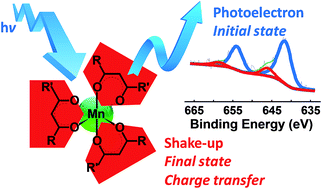Significance of the electron-density of molecular fragments on the properties of manganese(iii) β-diketonato complexes: an XPS and DFT study
Abstract
DFT and XPS studies were conducted on a series of nine manganese(III) complexes of the general formula [Mn(β-diketonato)3], with the ligand β-diketonato = dipivaloylmethanato (1), acetylacetonato (2), benzoylacetonato (3), dibenzoylmethanato (4), trifluoroacetylacetonato (5), trifluorothenoylacetonato (6), trifluorofuroylacetonato (7), trifluorobenzoylacetonato (8) and hexafluoroacetylacetonato (9). The binding energy position of the main and satellite structures of the Mn 2p3/2 photoelectron line, as well as the spin–orbit splitting, gave insight into the electronic structure of these manganese(III) complexes. DFT calculations showed that an experimental sample of the d4 [Mn(β-diketonato)3] complex can contain a mixture of different bond stretch isomers and different electronic states, in dynamic equilibrium with one other. The presence of more than one isomer in the experimental sample, as well as interaction between an unpaired 2p electron (originating after photoemission) and an unpaired 3d electron, which aligned anti-parallel to the unpaired 2p electron, caused broadening of the Mn 2p photoelectron lines. Multiplet splitting simulations of these photoelectron lines, similar to those calculated by Gupta and Sen for the free Mn(III) ion, gave good fits with the observed Mn 2p3/2 photoelectron lines. The XPS spectra of complexes with unsymmetrical β-diketonato ligands were simulated with two sets of multiplet splitting peaks, representing both the mer and fac isomers. The satellite structures obtained in both the Mn 2p3/2 photoelectron line (shake-up peaks) and the ligand F 1s photoelectron line (shake-down peaks), are representative of the ligand-to-metal charge transfer during photoionisation. The binding energies of the Mn 2p, F 1s and S 2p electrons, as well as the amount of charge transfer from ligand-to-metal, are both dependent on the electronegativity of the different groups attached to the β-diketonato ligand.



 Please wait while we load your content...
Please wait while we load your content...